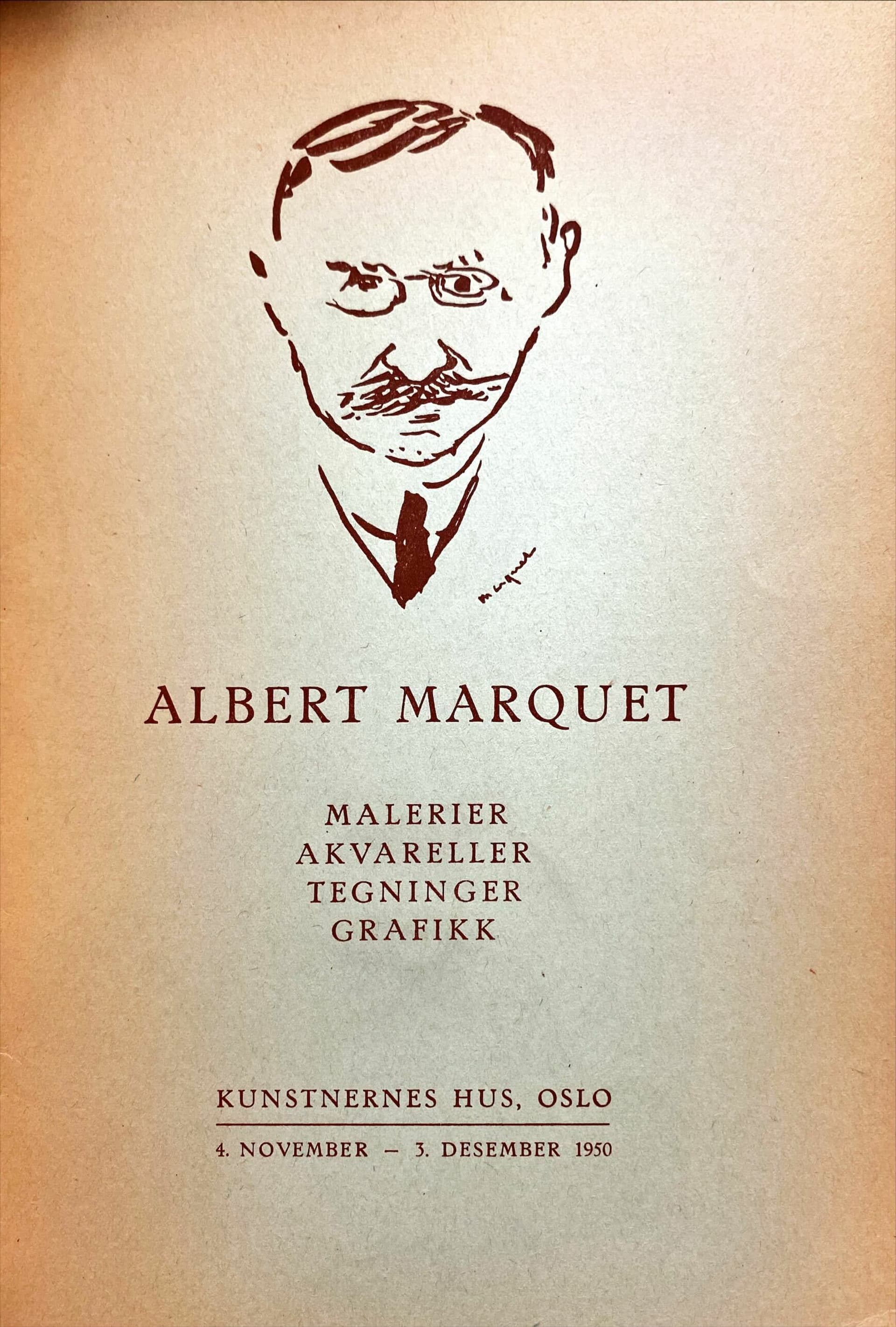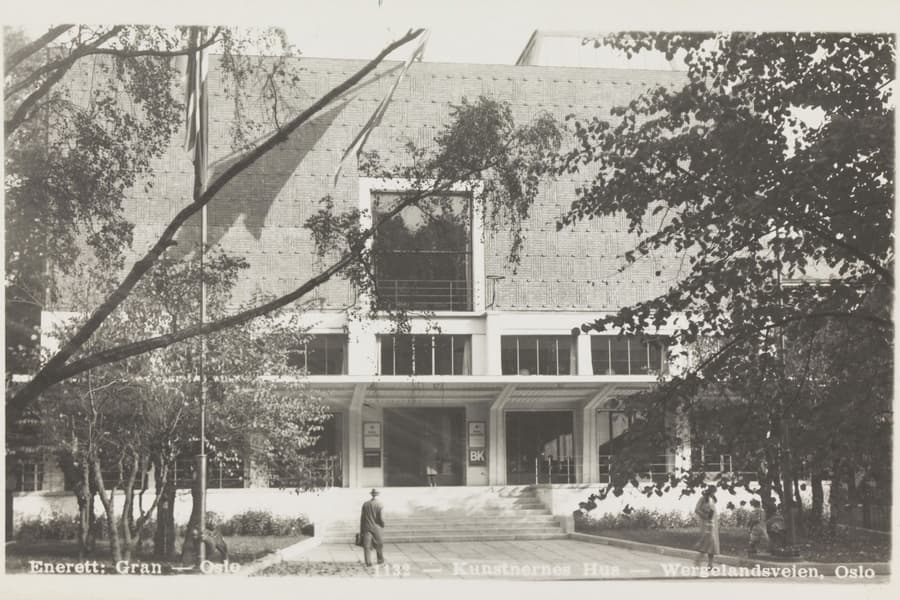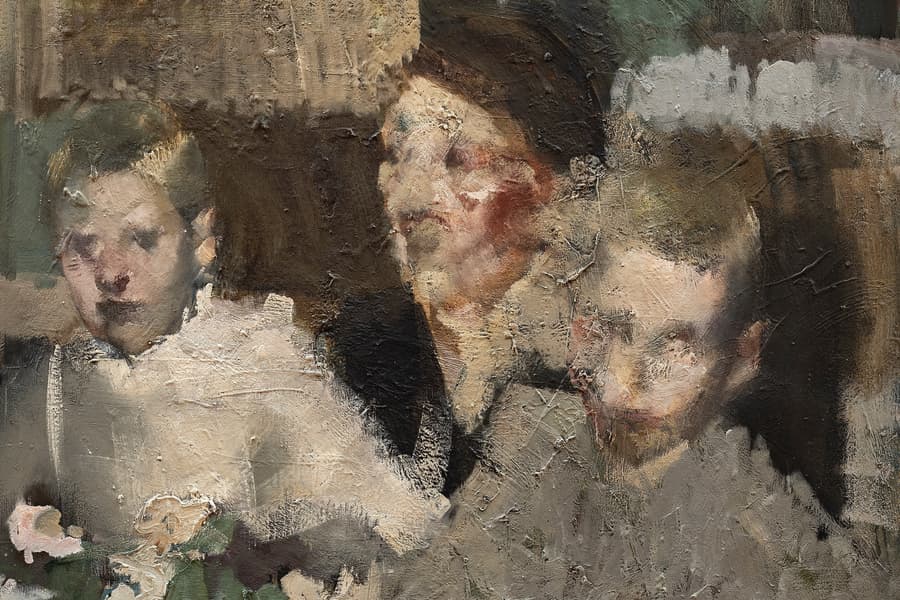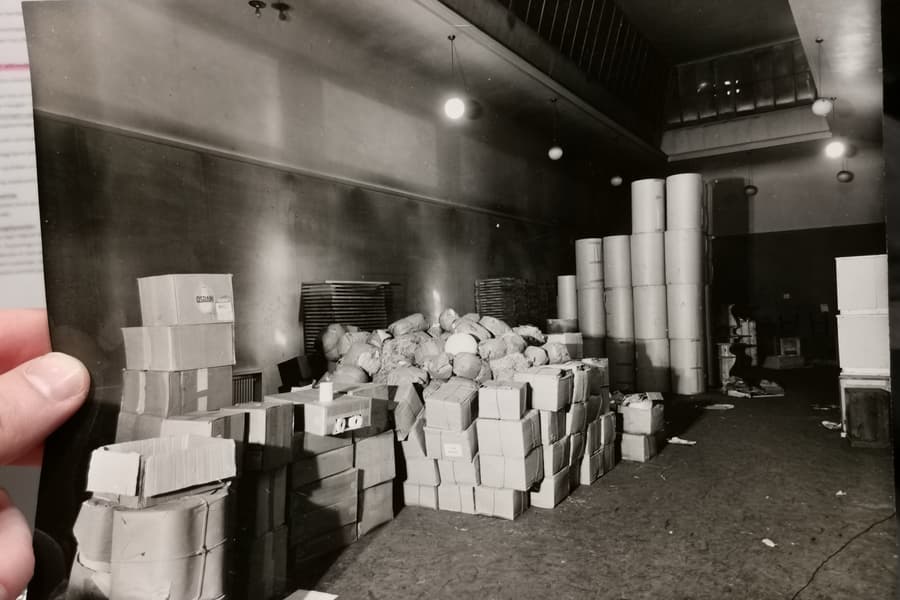Albert Marquet

In 1950, Kunstnernes Hus held a memorial exhibition for the French artist Albert Marquet. The exhibition consisted of a total of 111 paintings, drawings, watercolors and graphic works produced by the artist. Marquet was a good friend of the French artist Henri Matisse. In addition to a text about Marquet's relationship with Matisse, written by Walther Halvorsen, the exhibition catalog also contained a portrait of Marquet painted by Matisse.
Catalog text
The old tenement number 19 on Quai St. Michel will probably one day have its included facade decorated with memorial plaques that say that the painters Henri Matisse and Albert Marquet once lived here. For 20 years they lived there, Matisse and his family four stairs up, Marquet alone upstairs.
There at Matisse's one spring day in 1916, I met Marquet for the first time. Matisse and he were connected by a friendship that had been hardened by daily contact during the very difficult youth years.
In 1897 Marquet entered the Academy in Gustave Moreau's class where Matisse already was. Marquet benefited from the academic study, on the one hand, technically; by the understanding guidance of Moreau, on the other hand by the strongly abhorrent reaction to the macabre spinning tops that the professor himself produced as executive painter. At the sight of them, Marquet was strengthened in his conviction that the motifs had to be sought in the wild and fresh air and painted as straightforwardly and simply as possible. As a boy he had tumbled in the port of Bordeaux, and for him seas and ports and great rivers and everything that then flows were the most alive on this earth.
In Paris, he had the Seine outside his windows first on Quai St. Michel, and many years later when he and his wife moved into a corner yard on Quai des Grands Augustins. Paris became Marquet's permanent work base, from where he made all his travels to port cities in France, in almost all European countries and in Tunis and Algiers. This exhibition includes paintings, watercolors and drawings from twenty port cities.
Matisse's living room had the atmosphere created by a capital with 13th century ornamentation, a composition with bathing young boys by Cezanne, Spanish-Arabic faience, old French and Italian silk fabrics, vases and dishes with flowers and fruits, goldfish in a large cylindrical glass vessel, a beautiful table, good chairs and Matisse's own paintings. Here he painted sitting himself in the middle of his motif and became one with it. In the interior, which was painted against the light, the window stood like a bright surface in the background, where it was barely hinted at what Matisse saw through it from her place deep in the living room. The space was given its depth with each object in place balanced in its entirety by pure colors, inserted into the various plans by an ingenious painter, who without the use of denominations and perspectives created the impression of the third dimension by inexplicable, instinctive knowledge of the degree of the different colors' relative displacement inwards into the space from the surface.
The living room at Marquet had its justification as a workplace only by its view from the window. By the window stood his easel and the paint box and brushes in a jar on a stool, otherwise the room was furnished with the most necessary things: a table, some chairs and a divan.
From this window Marquet has created the intensely vivid picture of the most beautiful in the world's most beautiful city - in all weathers and in all seasons he painted the Seine with bridges and trees and houses along the quays, here are denominations and perspectives, the Seine is the Seine, bridges are bridges , trees are toes and house is house. Once seen, these pictures are not forgotten.
In September 1916, four of Matisse's paintings were carried up from Matisse's apartment to Marquet's living room, including an interior with the goldfish as the centerpiece of the motif. I hung them on the long wall with four of Marquet's pictures, three from the Seine and one from the port of Marseilles. On top of it all, I attached the portrait of Marquet painted by Matisse and sat down and looked at this according to common concepts desperate mounting. The nine paintings were to be sent together with many others to the Artists' Association in Kristiania, where an exhibition of modern French art was to be opened. After a while I was gripped by a strong desire that just like here these pictures should be hung in the Artists' Association, so that my friends there could sit in front of them like me here, sink like me in the contemplative calm, which Matisse's paintings trigger, live. into the silence of Matisse's living room, and then look at Marquet's paintings and without getting up see the Seine with bridges and quays and hear the carriages rolling down there and the bell ringing from Notre-Dame.
I've spent two summers with Marquet. One summer in La Chaume, a fishing village on the Vendé coast, and another on Hesnes near Grimstad, to which he and Mrs. Marquet came in 1925.
In La Chaume there was life from the sixty tuna skates that went out at high tide early in the morning, and when they came in at high tide in the evening with the tuna hanging along the rows, all the village women, young and old, stood with big, white butterfly-like headgear on the pier to receive. Marquet was well rested and every single day was a good working day for him.
At Hesnes he did not get a proper turn on it, I had the impression. It was a heat there that summer that surpassed what Marquet had experienced the summers in Tunis and Algiers and he often failed to paint outside. Perhaps he had also thought of Hesnes as something like La Chaume and Grimstad, as a port town with jetty cranes and lighthouses, with large boats at anchor and small ones speeding in and out, lovely things to paint.
That summer, however, I learned more than ever to appreciate him, his good humor, his clear intelligence, and his warm heart. Towards people and their actions he had a judgment that testified to wisdom and experience, a couple of times I saw him tighten over something stupid and tacky, then he spoke more slowly, even more quietly than usual, the smile did not leave him, but the voice had a undertone of dangerous irony. Then he suddenly struck with a lightning-quick reply and hit.
He was superbly indifferent to official honors, but could be captivatingly boyish when he managed in a short turn small everyday things. Like an evening we darted around the Hesnes Islands. Marquet, who was not a big guy, suddenly got up and began to pull in a tight vibrating line with all his might. The excitement made his eyes shine under the spectacles and his black mustache more brittle than it otherwise was on a daily basis. Proud and triumphant like a victorious gladiator, he hoisted over the grouse a bouncing five kilos of saithe and held it up in front of us.
Walther Halvorsen.
Om kunstneren
Albert Marquet var en fransk kunstner. Byskildringer og landskaper var et


